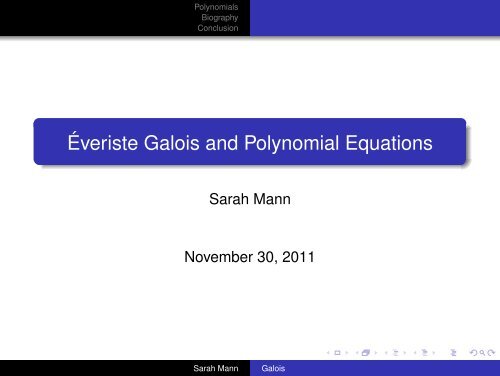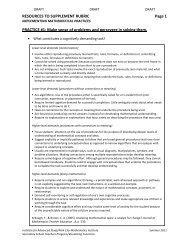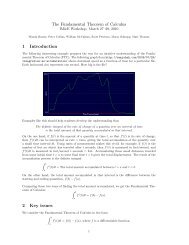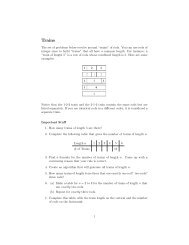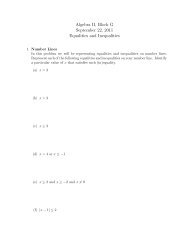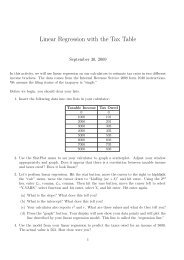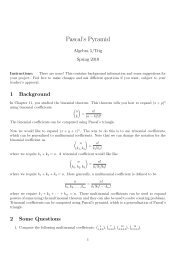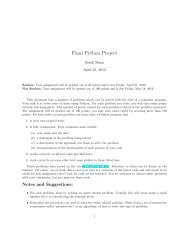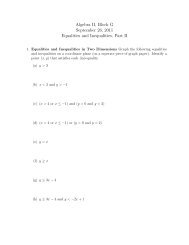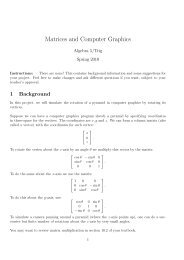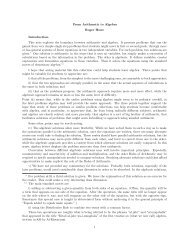Evariste Galois and Polynomial Equations - Institute for Mathematics ...
Evariste Galois and Polynomial Equations - Institute for Mathematics ...
Evariste Galois and Polynomial Equations - Institute for Mathematics ...
You also want an ePaper? Increase the reach of your titles
YUMPU automatically turns print PDFs into web optimized ePapers that Google loves.
<strong>Polynomial</strong>s<br />
Biography<br />
Conclusion<br />
Éveriste <strong>Galois</strong> <strong>and</strong> <strong>Polynomial</strong> <strong>Equations</strong><br />
Sarah Mann<br />
November 30, 2011<br />
Sarah Mann <strong>Galois</strong>
Warm Up<br />
<strong>Polynomial</strong>s<br />
Biography<br />
Conclusion<br />
Problem: Find the side of a square given that the area minus<br />
the side is 870.<br />
Sarah Mann <strong>Galois</strong>
Warm Up<br />
<strong>Polynomial</strong>s<br />
Biography<br />
Conclusion<br />
Problem: Find the side of a square given that the area minus<br />
the side is 870.<br />
Solution Let x represent the side of the square. Then the area<br />
is x 2 , <strong>and</strong> the problem translates to<br />
x 2 − x = 870.<br />
Sarah Mann <strong>Galois</strong>
<strong>Polynomial</strong>s<br />
Biography<br />
Conclusion<br />
We can solve this by completing the square:<br />
x 2 − x = 870<br />
x 2 − x + 1<br />
4<br />
= 8701<br />
4<br />
Sarah Mann <strong>Galois</strong>
<strong>Polynomial</strong>s<br />
Biography<br />
Conclusion<br />
We can solve this by completing the square:<br />
x 2 − x = 870<br />
x 2 − x + 1<br />
4<br />
<br />
x −<br />
= 8701<br />
4<br />
1<br />
2 2<br />
= 870 1<br />
4<br />
Sarah Mann <strong>Galois</strong>
<strong>Polynomial</strong>s<br />
Biography<br />
Conclusion<br />
We can solve this by completing the square:<br />
x 2 − x = 870<br />
x 2 − x + 1<br />
4<br />
<br />
x −<br />
= 8701<br />
4<br />
1<br />
2 2<br />
= 870 1<br />
x −<br />
4<br />
1<br />
2<br />
=<br />
<br />
± 870 1<br />
4<br />
Sarah Mann <strong>Galois</strong>
<strong>Polynomial</strong>s<br />
Biography<br />
Conclusion<br />
We can solve this by completing the square:<br />
x 2 − x = 870<br />
x 2 − x + 1<br />
4<br />
<br />
x −<br />
= 8701<br />
4<br />
1<br />
2 2<br />
= 870 1<br />
x −<br />
4<br />
1<br />
2<br />
=<br />
<br />
± 870 1<br />
4<br />
x = 1<br />
± 291<br />
2 2<br />
x = −29 or 30<br />
Sarah Mann <strong>Galois</strong>
<strong>Polynomial</strong>s<br />
Biography<br />
Conclusion<br />
We can solve this by completing the square:<br />
x 2 − x = 870<br />
x 2 − x + 1<br />
4<br />
<br />
x −<br />
= 8701<br />
4<br />
1<br />
2 2<br />
= 870 1<br />
x −<br />
4<br />
1<br />
2<br />
=<br />
<br />
± 870 1<br />
4<br />
x = 1<br />
± 291<br />
2 2<br />
x = −29 or 30<br />
Taking the side length to be positive, we find that the side<br />
length is 30.<br />
Sarah Mann <strong>Galois</strong>
Warm Up<br />
<strong>Polynomial</strong>s<br />
Biography<br />
Conclusion<br />
This problem <strong>and</strong> solution was found on a Babylonian clay<br />
tablet from 1600 BC.<br />
Its solution involves finding the roots of a quadratic<br />
equation.<br />
Finding the roots of polynomials has been a quest of<br />
mankind <strong>for</strong> thous<strong>and</strong>s of years.<br />
Sarah Mann <strong>Galois</strong>
<strong>Polynomial</strong>s<br />
Biography<br />
Conclusion<br />
A polynomial is a function of the <strong>for</strong>m<br />
with a finite degree.<br />
Examples:<br />
x − 5<br />
x 2 − 1<br />
x 3 − x + 2<br />
ax n + . . . + bx 3 + cx 2 + dx + e<br />
5x 16 − 4x 13 + .... + 2x − 7<br />
Sarah Mann <strong>Galois</strong>
<strong>Polynomial</strong>s<br />
Biography<br />
Conclusion<br />
The root of the polynomial, p(x) is the value of x at which the<br />
polynomial is 0; the solution to the equation p(x) = 0.<br />
Examples:<br />
x − 5 has root 5.<br />
x 2 − 1 has roots +1 <strong>and</strong> −1.<br />
x 3 − x + 2 has roots 0, 2, <strong>and</strong> −1.<br />
Sarah Mann <strong>Galois</strong>
<strong>Polynomial</strong>s<br />
Biography<br />
Conclusion<br />
In the 15 hundreds in Europe, mathematicians would engage in<br />
public math contests in which they would demonstrate their<br />
computational prowess. Computing roots of polynomials was<br />
one such tasks on which they competed.<br />
For some polynomials there are <strong>for</strong>mulas <strong>for</strong> finding the roots.<br />
Such <strong>for</strong>mulas gave mathematicians a competitive advantage if<br />
their opponents did not know the <strong>for</strong>mula.<br />
Sarah Mann <strong>Galois</strong>
<strong>Polynomial</strong>s<br />
Biography<br />
Conclusion<br />
The Quadratic Equation<br />
For polynomials of the <strong>for</strong>m<br />
ax 2 + bx + c we have the<br />
quadratic equation:<br />
x = −b±<br />
√<br />
b2−4ac 2a<br />
The Babylonians knew this<br />
method by 1600 BC.<br />
Sarah Mann <strong>Galois</strong>
<strong>Polynomial</strong>s<br />
Biography<br />
Conclusion<br />
The Cubic <strong>and</strong> Quartic<br />
Similarly, there exists a <strong>for</strong>mula (known by 1535) that gives the<br />
roots of the cubic polynomial,<br />
<strong>and</strong> the quartic (1545),<br />
ax 3 + bx 2 + cx + d,<br />
ax 4 + bx 3 + cx 2 + dx + e.<br />
Sarah Mann <strong>Galois</strong>
The Quintic<br />
<strong>Polynomial</strong>s<br />
Biography<br />
Conclusion<br />
But does there exist a <strong>for</strong>mula <strong>for</strong> the quintic equation,<br />
ax 5 + bx 4 + cx 3 + dx 2 + ex + f ?<br />
Sarah Mann <strong>Galois</strong>
The Quintic<br />
<strong>Polynomial</strong>s<br />
Biography<br />
Conclusion<br />
But does there exist a <strong>for</strong>mula <strong>for</strong> the quintic equation,<br />
ax 5 + bx 4 + cx 3 + dx 2 + ex + f ?<br />
A frenchman named Éveriste <strong>Galois</strong> answered this question in<br />
1832.<br />
Sarah Mann <strong>Galois</strong>
<strong>Polynomial</strong>s<br />
Biography<br />
Conclusion<br />
Éveriste <strong>Galois</strong> (October 25, 1811 - May 31, 1832)<br />
Sarah Mann <strong>Galois</strong><br />
Born in the French Empire to<br />
educated <strong>and</strong> intelligent parents<br />
Was a radical republican during<br />
the reign of Louis the XVIII, <strong>and</strong><br />
was jailed <strong>for</strong> his revolutionary<br />
activities<br />
Made major contributions to<br />
mathematics, although most of<br />
his work was not published<br />
during his lifetime<br />
Died in a dual in 1832 at the age<br />
of 20
Education<br />
<strong>Polynomial</strong>s<br />
Biography<br />
Conclusion<br />
<strong>Galois</strong> was educated by his mother until he was 12<br />
Then entered a preparatory school, the College de<br />
Louis-de-Gr<strong>and</strong><br />
He per<strong>for</strong>med well during his first two years, but got bored<br />
<strong>and</strong> had to repeat a year because his rhetoric work was<br />
not up to st<strong>and</strong>ard<br />
During this time he first became serious about math <strong>and</strong><br />
read Legendre’s Élements de Géométric like a novel<br />
By age 15 he was reading research papers in mathematics<br />
<strong>and</strong> neglecting his other studies<br />
Sarah Mann <strong>Galois</strong>
<strong>Polynomial</strong>s<br />
Biography<br />
Conclusion<br />
Education (Continued)<br />
He took the entrance exam <strong>for</strong> the École Polytechnique,<br />
the most prestigious school <strong>for</strong> mathematics in France at<br />
the time, but failed the examination<br />
His father committed suicide in 1829 after a bitter political<br />
dispute with the village priest<br />
A few days later <strong>Galois</strong> once again took the entrance exam<br />
<strong>for</strong> the École Polytechnique, <strong>and</strong> once again failed mostly<br />
due to his poor explanation of his ideas<br />
He entered the École Normal instead in 1830<br />
He was kicked out in 1831 <strong>for</strong> his political activism<br />
Sarah Mann <strong>Galois</strong>
Final Years<br />
<strong>Polynomial</strong>s<br />
Biography<br />
Conclusion<br />
<strong>Galois</strong> continued his study of <strong>and</strong> scholarship in<br />
mathematics after leaving the École Normal.<br />
Joined the National Guard, which was disb<strong>and</strong>ed shortly<br />
thereafter out of fear the guard might destabilize the<br />
government<br />
<strong>Galois</strong> was imprisoned <strong>for</strong> several months due to his<br />
political activism. He used this time to work on his<br />
mathematical research.<br />
He was killed in a dual with a friend, probably over a girl,<br />
on May 30, 1832<br />
The night be<strong>for</strong>e he wrote many letters to friends. In one of<br />
these he outlined his mathematical research <strong>and</strong> attached<br />
some manuscripts on which he had been working.<br />
Sarah Mann <strong>Galois</strong>
<strong>Galois</strong>’ Work<br />
<strong>Polynomial</strong>s<br />
Biography<br />
Conclusion<br />
<strong>Galois</strong>’ work in mathematics was deep <strong>and</strong> rich <strong>and</strong> <strong>for</strong>ms the<br />
basis <strong>for</strong> <strong>Galois</strong> Theory, an active area of mathematical<br />
research today. Amongst other things, this theory can be used<br />
to underst<strong>and</strong> the roots of polynomial equations.<br />
None of <strong>Galois</strong>’ work was published during his lifetime.<br />
Although he gained some recognition amongst mathematicians<br />
of his time <strong>for</strong> his promise, his explanation of his ideas was<br />
poor <strong>and</strong> his papers thus unpublishable. After his death his<br />
friends <strong>and</strong> other mathematicians went through his papers <strong>and</strong><br />
popularized his ideas.<br />
Sarah Mann <strong>Galois</strong>
The Quintic<br />
<strong>Polynomial</strong>s<br />
Biography<br />
Conclusion<br />
Does there exist a <strong>for</strong>mula <strong>for</strong> the quintic equation,<br />
ax 5 + bx 4 + cx 3 + dx 2 + ex + f ?<br />
Sarah Mann <strong>Galois</strong>
The Quintic<br />
<strong>Polynomial</strong>s<br />
Biography<br />
Conclusion<br />
<strong>Galois</strong> answered "No". He showed there is no explicit <strong>for</strong>mula<br />
<strong>for</strong> the quintic. There are no general <strong>for</strong>mulas <strong>for</strong> polynomials of<br />
degree 5 or higher.<br />
Sarah Mann <strong>Galois</strong>
Referneces<br />
<strong>Polynomial</strong>s<br />
Biography<br />
Conclusion<br />
http:<br />
//en.wikipedia.org/wiki/<strong>Evariste</strong>_<strong>Galois</strong><br />
http://www.gap-system.org/~history/<br />
Biographies/<strong>Galois</strong>.html<br />
Stewart, Ian. <strong>Galois</strong> Theory. Third Edition. Chapman &<br />
Hall/CRC, 2004.<br />
Sarah Mann <strong>Galois</strong>


